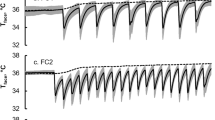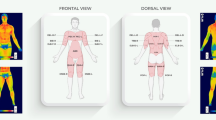Abstract
Physical exercise induces the thermoregulation process of the human body, in order to avoid overheating produced by muscle contraction. The infrared thermographic image (ITI) is an option to assess the change in body temperature, as it monitors the physiological functions related to the control of the skin surface temperature in real-time. The aim of the present research was to verify the effectiveness of infrared thermography as an instrument for monitoring the central body temperature through the facial thermal behavior of individuals pre, post and 24 h post-CrossFit® training workout. This study evaluated 10 adults’ volunteers of both sexes, physically active, practitioners of CrossFit®, with a body mass index of 23.79 ± 2.66 kg/m2. The training consisted of typical exercises of the modality CrossFit® and lasted 50 min. The athletes were monitored for 24 h, with acquisition of facial thermographic images in the Pre-Workout, Post-Workout moments and 24 h after training. The maximum (Tmax) and average (Tmed) temperatures were chosen to analyze the results, both for the front and side views. There was no difference in skin temperature between the regions of interest (p > 0.05), both for Tmax and Tmed at different times. It can be concluded that thermography is a tool for monitoring the central body temperature, through the facial thermal behavior, of individuals during a CrossFit® training, and also that the CrossFit® practitioners evaluated presented a good thermoregulation capacity, managing to effectively dissipate the heat produced in the training after 24 h of evaluation.
Access this chapter
Tax calculation will be finalised at checkout
Purchases are for personal use only
Similar content being viewed by others
References
Pagan LU, Gomes MJ, Okoshi MP. (2018) Endothelial function and physical exercise. Arq Bras Cardiol
Guyton AC, Hall EJ (2015) Guyton and Hall textbook of medical physiology. Elsevier Saunders, Philadelphia, pp 911–919
Burnham RS, McKinley RS, Vincent DD (2006) Three types of skin-surface thermometers: a comparison of reliability, validity, and responsiveness. Am J Phys Med Rehabil 85(7):553–558
Johnson JM (1992) Exercise and the cutaneous circulation. Exerc Sport Sci Ver 20:59–97
Dibai FAV, Guirro RRJ (2014) Evaluation of myofascial trigger points using infrared thermography: a critical review of the literature. J Manip Physiol Ther
Ferreira JJ, Mendonça LC (2008) Exercise-associated thermographic changes in young and elderly subjects. Ann Biomed Eng 36(8):14–20
Schlader ZJ, Coleman GL, Sackett JR, Sarker S et al (2017) Behavioral thermoregulation in older adults with cardiovascular co-morbidities. Temperature (Austin) 5(1):70–85
Moran S, Booker H, Staines J, Williams S (2017) Rates and risk factors of injury in CrossFit®: a prospective cohort study. J Sports Med Phys Fitness 57(9):1147–1153
Meyer J, Morrison J, Zuniga J (2017) The benefits and risks of CrossFit®: a systematic review. Workplace Health Saf 65(12)
Sprey JWC, Ferreira T, Lima MV et al (2016) An epidemiological profile of CrossFit® athletes in Brazil. Orthop J Sports Med 4(8)
Claudino JG, Gabbett TJ, Bourgeois F et al (2018) CrossFit® overview: systematic review and meta-analysis. Sports Med Open 4(1):11
Warvaz GR, Suric V, Daniels AH et al (2016) Crossfit® instructor demographics and practice trends. Orthop Ver (Pavia) 8(4):6571
Eather N, Morgan PJ, Lubans DR (2016) Improving health-related fitness in adolescents: the CrossFit® teens™ randomized controlled trial. J Sports Sci 34(3):209–223
Charkoudian N (2003) Skin blood flow in adult human thermoregulation: how it works, when it does not and why. Mayo Clin Proc 78:603–612
Fernandez-Cuevas I, Marins JCB, Lastras JA et al (2015) Classification of factors influencing the use of infrared thermography in humans: a review. Infrared Phys Technol 71:28–55
Ring EFJ, Ammer K (1998) Thermal imaging in sports medicine. Sport Med Today 1(2):108–109
Brukner P, Khan K (2012) Clinical sports medicine, 4ª edn. McGraw-Hill, Australia, 1268 p. ISBN-13 978-0-07099-813-1
Bryan AD, Hutchison KE, Seals DR, Allen DL (2007) A transdisciplinary model integrating genetic, physiological, and psychological correlates of voluntary exercise. Health Psychol 26:30–39
Magnan RE, Kwan BM, Bryan AD (2013) Effects of current physical activity on affective response to exercise: physical and social-cognitive mechanisms. Psychol Health 28:418–433
Hensel H (1981) Thermoreception and temperature regulation. Monogr Physiol Soc 38:1–321
Haddad DS, Brioschi ML, Baladi MG et al (2016) A new evaluation of heat distribution on facial skin surface by infrared thermography. Dentomaxillofac Radiol 45:20150264
Getson P et al (2019) Guidelines for dental-oral and systemic health infrared thermography. Pan Am J Med Thermol [S.l.] 5:41–55
Haddad DS, Brioschi ML, Arita ES (2012) Thermographic and clinical correlation of myofascial trigger points in the masticatory muscles. Dentomaxillofac Radiol 41(8):621–629
Mougios V, Deligiannis A (1993) Effect of water temperature on performance, lactate production and heart rate at swimming of maximal and submaximal intensity. J Sports Med Phys Fitness 33:27–33
Haddad DS, Brioschi ML, Vardasca R et al (2014) Thermographic characterization of masticatory muscle regions in volunteers with and without myogenous temporomandibular disorder: preliminary results. Dentomaxillofac Radiol 43:20130440
Haddad DS, Oliveira BC, Brioschi ML et al (2019) Is it possible myogenic temporomandibular dysfunctions change the facial thermal imaging? Clin Lab Res Dent 2019:1–10. http://dx.doi.org/10.11606/issn.2357-8041.clrd.2019.158306
Gratt BM, Sickles EA (1995) Electronic facial thermography: an analysis of asymptomatic adult subjects. J Orofac Pain 9:255–265
Weinstein SA, Weinstein G, Weinstein EL et al (1991) Facial thermography, basis, protocol, and clinical value. Cranio 9:201–211
Brioschi ML, Teixeira MJ, Silva MF (2010) Princípios e Indicações da Termografia Médica, 1st edn. Andreoli, São Paulo
Bernard V, Staffa E, Mornstein V et al (2013) Infrared camera assessment of skin surface temperature–effect of emissivity. Phys Med 29(6):583–591
Bandeira F, Neves EB, Moura MAM et al (2014) A termografia no apoio ao diagnóstico de lesão muscular no esporte. Rev Bras Med Esporte [online] 20(1):59–64
Kenney WL, Johnson JM (1992) Control of skin blood flow during exercise. Med Sci Sports Exerc 24(3):303–312
Johnson JM (1992) Exercise and the cutaneous circulation. Exerc Sport Sci Rev 20:59–97
Charkoudian N (2010) Mechanisms and modifiers of reflex induced cutaneous vasodilation and vasoconstriction in humans. J Appl Physiol 109:1221–1228
Fernandes AA, Amorim PRS, Prímola-Gomes TN et al (2020) Evaluation of skin temperature during exercise by infrared thermography: a systematic review. Rev Andal Med Deporte 5(3):113–117
Formenti D, Ludwig N, Gargano M et al (2013) Thermal imaging of exercise-associated skin temperature changes in trained and untrained female subjects. Ann Biomed Eng 41:863–871
Al-Nakhli HH, Petrofsky JS, Laymon MS et al (2012) The use of thermal infra-red imaging to detect delayed onset muscle soreness. J Vis Exp 59:3551
Demartino MMF, Simões ALB (2013) A comparative study of tympanic and oral temperatures in healthy adults. Rev Ciênc Méd Campinas 12(2):115–121
Amorim AMAM, Barbosa JS, Freitas APLF et al (2018) Infrared thermography in dentistry. HU Rev Juiz de Fora 44(1):15–22
De Martino MMF, Simões ALB (2013) A comparative study of tympanic and oral temperatures in healthy adults. Rev Ciênc Med (Campinas) 12(2):115–121
Abreu MM, Haddadin AS, Shields B et al (2015) Noninvasive surface monitoring of core temperature via a medial canthal brain temperature tunnel. In: The anestesiology annual meeting, American Society of Anesthesiology. Abstract archives, 24 Oct
Neves EB, Salamunes ACC, de Oliveira RM et al (2017) Effect of body fat and gender on body temperature distribution. J Therm Biol 70:1–8. https://doi.org/10.1016/j.jtherbio.2017.10.017
Salamunes ACC, WanStadnik AM, Neves EB (2017) The effect of body fat percentage and body fat distribution on skin surface temperature with infrared thermography. J Therm Biol 66:1–9. https://doi.org/10.1016/j.jtherbio.2017.03.006
Dibai Filho AV, Packer AC, de Souza Costa AC, Rodrigues-Bigaton D (2013) Accuracy of infrared thermography of the masticatory muscles for the diagnosis of myogenous temporomandibular disorder. J Manip Physiol Ther 36(4):245–252
Acknowledgements
We would like to say thanks to the Brazilian National Council for Scientific and Technological Development (CNPq) for financial support (303678/2018-6).
Conflict of Interest
The authors declare that they have no conflict of interest.
Author information
Authors and Affiliations
Editor information
Editors and Affiliations
Rights and permissions
Copyright information
© 2022 Springer Nature Switzerland AG
About this paper
Cite this paper
Castillo, D.B. et al. (2022). Facial Thermal Behavior Pre, Post and 24 h Post-Crossfit® Training Workout: A Pilot Study. In: Bastos-Filho, T.F., de Oliveira Caldeira, E.M., Frizera-Neto, A. (eds) XXVII Brazilian Congress on Biomedical Engineering. CBEB 2020. IFMBE Proceedings, vol 83. Springer, Cham. https://doi.org/10.1007/978-3-030-70601-2_254
Download citation
DOI: https://doi.org/10.1007/978-3-030-70601-2_254
Published:
Publisher Name: Springer, Cham
Print ISBN: 978-3-030-70600-5
Online ISBN: 978-3-030-70601-2
eBook Packages: EngineeringEngineering (R0)




